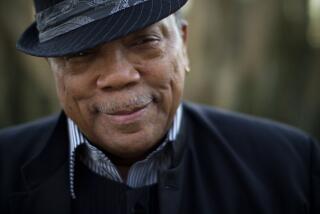Quincy Jones, the Architect and His Legacy
- Share via
“There is no unimportant architecture,” the late architect Quincy Jones once said, adding that everything in the built environment affects people and, in turn, the world, whether it is good or not so good.
It was with this attitude in mind that the Los Angeles-based Jones shaped a variety of distinguished projects in a prolific career as an architect and educator that spanned 34 years, ending in 1979.
Indeed, Jones designed almost every type of structure: inexpensive to luxurious single-family houses, garden apartments and apartment towers, small branch libraries and large university research libraries, school buildings, office complexes and factories, churches, performing arts centers, an embassy, a funeral parlor, a tennis club and an entire college campus.
For nearly 20 years, he was associated with the USC schools of architecture and fine arts and for a time served as the dean of the two schools.
The vast body of work generated by Jones by himself and with various associates over the years garnered about 70 awards. These included a 1950 honor award from the American Institute of Architects for the design of a house, and, in partnership with Frederick Emmons, the institute’s firm award in 1969. It remains the only Los Angeles firm to win the award.
Jones also designed a succession of houses for himself, the last being the 1965 conversion of a large, wood-clad photography studio at 10300 Little Santa Monica Blvd. near Century City into a stunning, singular home and office. Because the shape and materials resemble a New England barn, a mood Jones enhanced by planting clusters of trees on the street edging the site, the structure became known as the “barn.”
The barn will be open to the public from 3 to 6 p.m. Sunday as part of the Great Houses program of the USC Architectural Guild. (Admission is $15; or $10 for guild members, the proceeds go to the organization’s fellowship and scholarship programs. Information: (213) 470-6060.)
Despite its urban setting, adjacent to a busy boulevard and in the shadow of some cold commercial office structures, the barn as maintained by the architect’s widow, Elaine Sewell Jones, is a warm anomaly, a softly styled informal oasis in an increasingly frenetic setting.
The sense of space, the subtle natural and artificial lighting, the concern for detail, such as in the use of the re-sawed redwood and the wooden window grills, the selective furnishings and extensive plants are combined in the barn into a distinctly Modernistic Craftsman style. Whatever it might be called, the barn exudes a welcomed gentility.
Among the more prominent projects Jones and his associates designed in Southern California are the University Research Library at UCLA, the Annenberg School of Communications at USC, the chemistry building and carillon tower at UC Riverside, the Brentwood and Palos Verde branch libraries, the Warner Bros. Record building in Burbank, and the master plan for Cal State Dominguez Hills.
Jones also was involved in two noteworthy efforts in Los Angeles’ rich legacy of residential architecture, the Crestwood Hills project in Kenter Canyon in Brentwood, and the Case Study House program.
In Crestwood, he joined with architect Whitney Smith and engineer Edgardo Contini to design a number of attractive, modest, functional houses as part of a cooperative housing effort. And while the cooperative faltered, the housing in time flourished, to set an example of sensitive land-use planning and design.
As for the Case Study House program, Jones was one of a number of architects selected to design individual houses to showcase how the latest construction materials and methods might be adapted to produce attractive, affordable structures.
Though his custom projects generally were in a Modernist mode popular in the 1950s and ‘60s, Jones was not a stylistic ideologist. “His designs grew out of the problems, and within the constraints of materials, space, the site and the budget,” explained his widow, who is cataloguing the architect’s writings and voluminous drawings.
“And always on his mind,” she said, “was the need of the user, the people who would use the building, whether a place to live, or work, play or worship. That’s what his architecture was all about.”
More to Read
The biggest entertainment stories
Get our big stories about Hollywood, film, television, music, arts, culture and more right in your inbox as soon as they publish.
You may occasionally receive promotional content from the Los Angeles Times.










